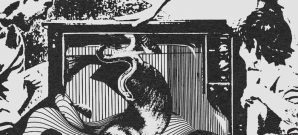 Once upon a time… or maybe twice, there was an unearthly paradise called Pepperland.
Once upon a time… or maybe twice, there was an unearthly paradise called Pepperland.
Today, the stars of music are multimedia experts, performing on various platforms in various ways, but it wasn’t always so easy. Before there was live streamed shows, music videos, and all the rest, when rock and pop were still flush and new, there was Yellow Submarine by The Beatles. The animated fairytale of the boys’ trip to save the music-loving paradise of Pepperland from the music-hating Blue Meanies featured classic songs in new-fangled animation, lifting both to new heights of critical and commercial acclaim. And now Yellow Submarine gets a frame-by-frame digitally restored release.
The plot of Submarine is a fairly silly and surreal one, with The Beatles being recruited by the submarine’s captain Old Fred to rescue Pepperland from its conquest by the Blue Meanies, who have immobilized all the people of Pepperland (including the band). The Yellow Submarine’s journey back to Pepperland takes it through various ultra-surreal seas (and one foothills), with the boys losing Ringo and getting him back again, finding "Nowhere Man" Jeremy Hilary Boob PhD and losing him, and even losing the submarine before making their way to Pepperland. In Pepperland, The Beatles sneak around to get the instruments of Sgt. Pepper’s Lonely Hearts Club Band, then later free the band itself (who are versions of The Beatles, as John hilariously over-intelligently explains), defeating the Blue Meanies, with the Chief Blue Meanie being transformed by Jeremy into a friend.
All of this is done in animation, in a colorful style that is neither too psychedelic nor too Disney, and the restoration is impressive. Done by hand-cleaning each frame, rather than automated software, it is striking and refreshing to see material so clearly of the sixties but in the digital quality of today. This also comes out the most when the boys make a live action appearance at the end – their only actual appearance in the movie, save for their songs, as their voices otherwise were done by other actors. To see John, Paul, George, and Ringo, icons known the world over (and by their first names, to boot), in picture-perfect 1968 flesh (just before their famed trip to India), is amazing. Meanwhile, the art keeps reminding one of other great animation, such as Terry Gilliam’s in Monty Python’s Flying Circus – but then you release that it was Gilliam and the rest who took their inspiration from Yellow Submarine.
Voicing by other actors allows the Fab Four to be slightly cartooned in voice as well as image, without losing their distinctive personalities – Ringo particularly shines, whether bemoaning his lack of imagination at the start, or proclaiming that he knew that Jeremy would be somebody, back when he was nobody. There are numerous funny Liverpudlian plays on words, such as, "Oh look, it’s a Cyclops!" "It’s got two eyes." "Oh, then it must be a bicyclops…" Or "Time’s gone on strike." "Why?" "Shorter hours."
Oh, and the movie has some Beatles songs – which just happen to be some of the best of The Beatles (and we aren’t talking Pete Best…). Of course there’s the title track, but also the haunting "Eleanor Rigby", cheery "When I’m Sixty-Four", excellent "Nowhere Man", psychedelic "Lucy In the Sky with Diamonds", uproarious "Sgt. Pepper’s Lonely Hearts Club Band", two renditions of the sing-along "All Together Now", and more. But you don’t need a music reviewer to tell you about the greatness of the greatest band in rock ‘n’ roll.
Extras include the original theatrical trailer, storyboards of three sequences, original pencil drawings, behind the scenes photos, subtitles in thirteen different languages, and more. ‘Mod Odyssey’, a short making-of sequence from 1968, which compares the story to Gulliver’s Travels, Alice In Wonderland, and even The Odyssey, perhaps tries too hard to sell the film as high art, but is an interesting example of how music & movies were creatively sold to audiences (especially British audiences) over forty years ago.
There are short interviews with a few of the voice actors and behind the scenes personnel, and an audio commentary by producer John Coates, with additional commentary from art director Heinz Edelmann (who mentions that the Blue Meanies were originally supposed to be a bluish red, but his assistant accidentally made them blue…). In the commentary track, Coates discusses the impossibility of actually having The Beatles voice their own characters (you try rounding up the Fab Four and putting them in the studio in 1968…), seeing the film at a screening near his sixty-fourth birthday, one of the staff exiting their locked-up premises late at night via a window (and getting arrested), how there was far more alcohol consumed than any other drugs during the making (apparently a fiver could buy 20-30 people a round of drinks at the nearby ‘animator’s pub’), the difficulty of scenes like ‘The Sea of Holes’ ("With computers now, it’s easy as wink…"), hearing Sgt. Pepper’s early in Abbey Road Studios, and more. Perhaps best is the story of George’s vocal actor, Peter Batten, who Coates and director George Dunning found overhearing in a pub after an exhaustive, fruitless search. Batten was no professional actor or voice, indeed seemed to not have a job at all, but rather liked chatting up their art girls who were working there ("We had the best-looking girls, in their mini-skirts, that you ever saw…"), and one day one that he’d become particularly friendly with came into the office in tears. Apparently Batten was an army deserter, and had just been carted off by the military police…
Coates’ audio commentary is restrained and low-key in a charming English manner, generous in giving credit to others (down to bus-full of art school students brought in to help get the coloring done in time), especially Edelmann, and never aggrandizing himself. He mentions how The Beatles had very little criticism while it was being made, save for their own voices, ‘The other three are great, but you didn’t get my voice right.’ "Looking back, the whole world thinks it’s The Beatles’ own voices, so I think we got them right, and I think today they do as well…" He mentions famed Beatles producer George Martin ("Sir George now…") saying some of his favorite times was working on Yellow Submarine ("Now, I don’t know if that’s true, or if he was just saying that…"). Even on the less wonderful moments of making the movie, such as a contractual dispute with executive producer Al Brodax when they were behind schedule, or when the "Hey Bulldog" sequence near the end was removed and the end altered for the American version, are without bitterness. Coates is quite charming as he reflects on the bygone era, from having teens dancing in the aisles at a screening, blocking off streets whenever The Beatles came anywhere (including waiting with the band for Ringo’s auntie), and just the general inspiration and feeling of the time that inspired and was exemplified by the movie.
Yellow Submarine the movie couldn’t be as timeless as The Beatles’ music, because visual styles change much more severely and rapidly than music – and very, very little could be as timeless as The Beatles’ music. But the film is a wonderful expression of the band’s timeless tunes.


















